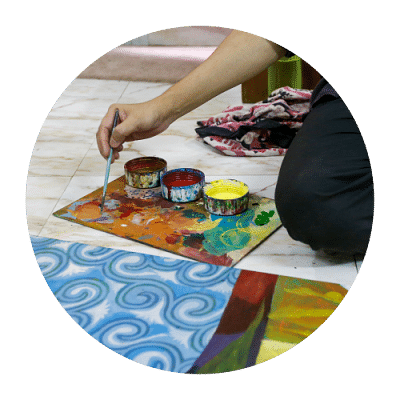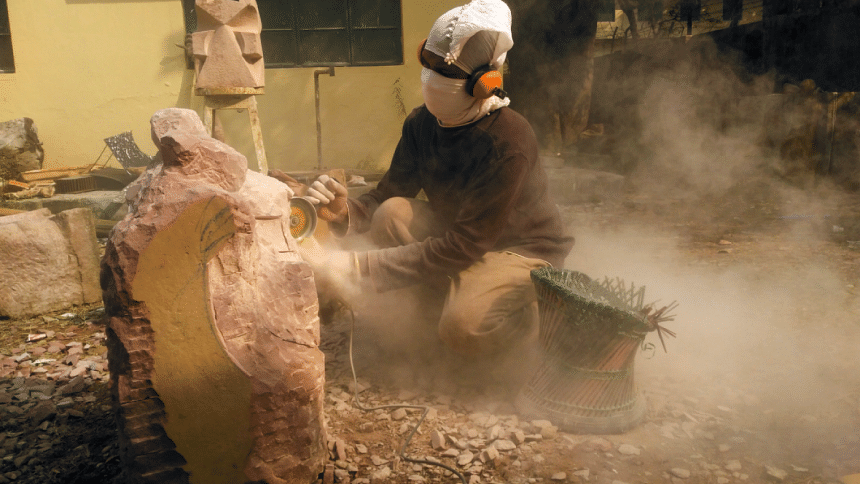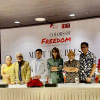Making a living through art in Bangladesh

For some, blank canvases and empty pages is the gateway to a world of infinite possibilities awaiting the genius of their brushstrokes. This urge to reimagine the world they reside in or create new ones emerge from doodles, watching cartoons, or drawing their "graam er drissho".
While the practice of turning your creative endeavours into a career is frowned upon, there is no denying that artists are here to stay. Moreover, it is now easier to get your work out to a larger audience. The existence of social media and sites such as Behance and ArtStation allows artists to create portfolios and helps in taking up requests and possible employment opportunities.
Many options have opened up for the artistically gifted, but the end goal for some is to sell original pieces. Whether it is a client found through social media, an acquaintance, or a gallery show, to be able to sell your art for a sum is a sign that they have made it.

It is no easy feat though. To be able to create demand for your art, especially in a closed-off market, requires the right connections. It takes time to break through and connect with an inaccessible circle, and to convince the same group of people to be paying top bucks for your creation is a completely different game.
As a result, selling original pieces becomes an outrageous prospect for aspiring young creatives. What gets attention, and hence, potential customers, are pieces from established names or widely recognised artworks.
A more feasible service offered by young artists are commissions. The question "Can you draw me?" should no longer irk them as they can finally put a price on the question. Portraits and caricatures boast a large audience and widespread demand. Such mediums can especially help those with the ability to render hyper-realistic pieces or ones with very distinct styles.
Artists can branch out even further. Murals are an option for those who love to paint. Walk into any cafe, and you can catch a glimpse of an ornamental concrete wall elevating the ambience. In recent years, office spaces and schools have also devoted themselves to establishing an identity in their premises. Interior design firms work closely with artists to work on murals and sometimes even outsource the mural entirely.
Children's book illustrations have also gained significant traction over the last few years. Amar Ekushey Boi Mela has seen a surge in the number of books geared towards toddlers. Publishers and independent writers are on the lookout for illustrators. These books tend to have a childish charm about the art style as they often deviate from a polished look and prefer illustrations reminiscent of children's scribbles. Therefore, depending on their strengths, the artist can work on orders they specialise in and carve a niche out for themselves.
Tahmeed Karim, a 22-year-old artist based in Chittagong, shares, "My first customers were my friends and classmates. Everyone used to recognise me as that kid who paints and sketches. That helped in getting the word out."
He adds, "I would go to comic cons, participate in school events as well as share work in art groups online. This helped gather momentum until eventually, it accumulated to somewhat of a stable client base."
Commission work and freelancing are options to consider but the underlying problem that often repels artists from pursuing them is the lack of security and its unsustainable nature. Unless there is a constant stream of orders for them to work on, there will be little to no income. As significant as commissions are to an artist, working exclusively on orders takes the joy out of the process. Artists have lamented about burnouts, creative blocks, and just a general lack of motivation when they spend all their time working.
Moreover, the process of gathering clients is arduous in and of itself. To gather a stable client base, one must have an online presence, accumulate recognition, and be deemed good enough amidst an abundance of content.
"When I first started, the rates were embarrassingly low. Anyone starting must remember that it is very difficult to convince people to pay for your art. The key to making it sustainable is to be willing to consistently put in the work," asserts Tahmeed.
Nevertheless, the golden age of content is somewhat of a jackpot for artists. TV shows, movies, video games, comic books, and graphic novels are all narrative mediums that require creatives and such content is being churned out at an unprecedented rate. From story-boarding to character design to designing the opening sequence, creating the final product requires an artist almost every step of the way.
Asifur Rahman, the mind behind Arts by Rats, says, "Locally, there is a handful of studios in the country with small teams. In such scenarios, artists usually work on numerous tasks simultaneously. At Mighty Punch Studios, I worked as a concept artist as well as a character designer while also involved as a background artist."
He continues, "There is no global standard as to how many artists a studio requires. Smaller studios have a smaller team with a more hands-on approach across all departments, which usually gives more leeway for individual expression."
In the long run, everyone aspires to work for the biggest studios but the fairy tale is a challenge. With opportunities few and far between and a system that provides an obstacle for creative pursuits, artists cannot thrive. The option to pursue a degree in any form of art is not only demeaned, but it is also very limited in the educational sphere of our country.
Asifur is currently pursuing a diploma in 3D Modelling, Art, and Animation from the British Columbia Institute of Technology. He feels as though the degree has given him a clear set of guidelines as well as instilled some discipline into the learning curve.
"Although you could find similar resources on the internet, there is just something about being taught by an industry professional that cannot be replaced. There is also the aspect of getting in touch with people who have experience in the field and establishing a network with such individuals goes a long way," Asif says.
Fortune certainly favours the bold, but to leap, one must at least take a look down at the drop. The many hurdles in the local creative field emerge from deep-lying systematic issues that put artists at a disadvantage. There is no denying that young creators will inevitably have their passion for art exploited, whether it is through low prices or long hours of work.

Moreover, the appeal of commercial art is very linear. The corporate art style of saturated palettes and skewed proportions has become infamous. Such standards not only deprive artists of fully showcasing the nuances of their style but also create restrictions that disrupt the fluidity of art.
Asif states," It is very unlikely that a studio will hire you based on your style. To catch their attention, artists should develop a portfolio that tailors to the needs of the said studio."
The harsh reality is that to obtain even a mellow grip on the industry, most artists will need to cater to the needs of the industry, and even then, there will truly be no guarantee of attaining your dream job.
However, all isn't doom and gloom. The local market is also participating in the mass stream of content. Video game studios are popping up across the country, and established comic book studios, as well as positions in newspaper outlets as cartoonists, have great opportunities for artists. On the other hand, those working with a more traditional medium can seek out openings in art director positions. Museums, TV studios, and marketing agencies all need an art director, and there are few cut out for the job as well as fine artists.
To be passionate about art is truly magical. It is rewarding and reassuring. There is marketing yourself, knowing your market, and setting the right prices – all of which develop with the artist. Obstacles and hurdles are only part of the process but there is no reason why it shouldn't become a reality. With foundational support and some fine tuning in the right places, the creative part of the economy will become a mainstay and perhaps even a source of pride for the country.
Abir Hossain is a failed SoundCloud Rapper. Tell him you too can't find anything to rhyme oranges with at fb/abir.hossain.19

 For all latest news, follow The Daily Star's Google News channel.
For all latest news, follow The Daily Star's Google News channel. 









Comments